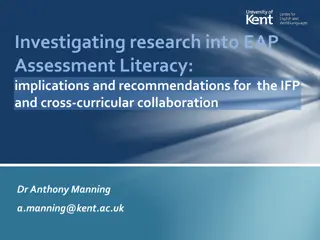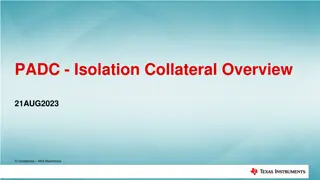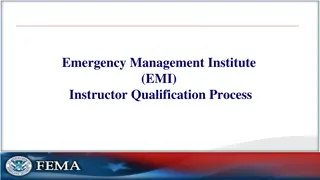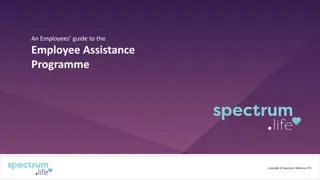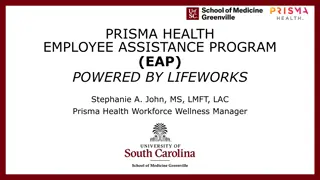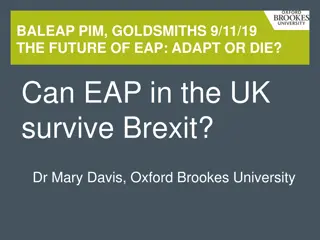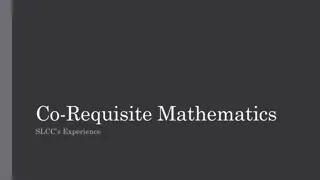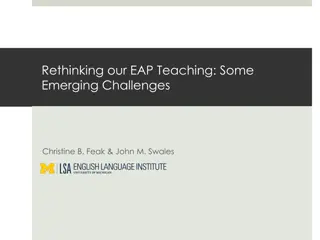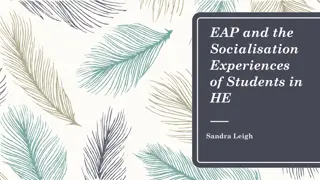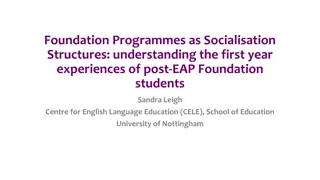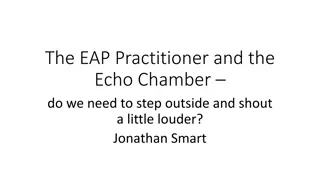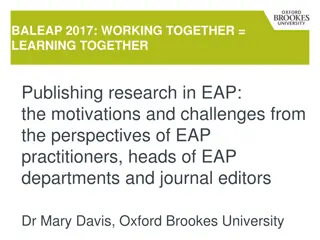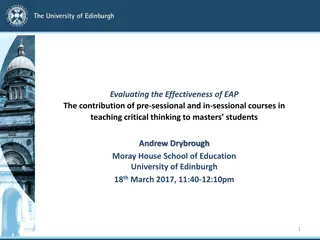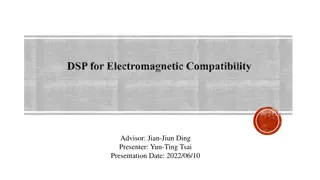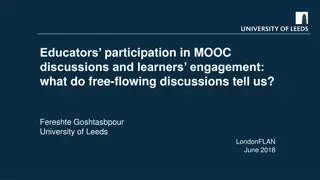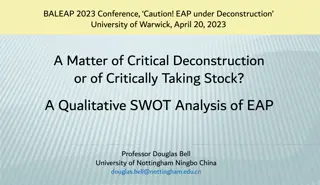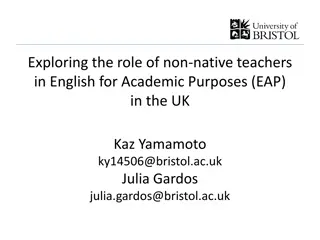
Perceptions of Requisite Teaching Qualifications in EMI Context by EAP Educators
Explore the perceptions of EAP educators regarding teaching qualifications in English-Medium Instruction (EMI) settings. Learn about the role of EAP in enhancing language proficiency for non-native English speakers studying academic subjects in English. Delve into the challenges and provisions required for effective EMI teaching.
Download Presentation

Please find below an Image/Link to download the presentation.
The content on the website is provided AS IS for your information and personal use only. It may not be sold, licensed, or shared on other websites without obtaining consent from the author. If you encounter any issues during the download, it is possible that the publisher has removed the file from their server.
You are allowed to download the files provided on this website for personal or commercial use, subject to the condition that they are used lawfully. All files are the property of their respective owners.
The content on the website is provided AS IS for your information and personal use only. It may not be sold, licensed, or shared on other websites without obtaining consent from the author.
E N D
Presentation Transcript
1 EAP educators' perceptions of the requisite teaching qualifications in EMI context BALEAP PIM 2022 Dr. Mehmet Altay, Kocaeli University, Turkey Dr. Dogan Yuksel, Kocaeli University, Turkey
2 Introduction The consensus on the nature of EMI is that it does not have an explicit aim to improve students English knowledge (e.g. West et al., 2015; Rose et al., 2019). Rather, it aims to teach content knowledge to NNES students in English (Dearden, 2016; Macaro, 2018).
4 Still, language proficiency has been the most heavily researched area in EMI studies (Chen, Han,& Wright, 2020) as it is a prerequisite of meaning-making in content courses. Therefore, one of the factors for ESP to emerge is to further learners language proficiency with a specific content focus (Richards, 2001). EAP, one of the two branches of ESP, addresses the need for academic language use (Woodraw, 2018).
5 Some perceived insights of EAP: EAP does not concern itself with the teaching of an academic subject in terms of its content EAP teachers are very rarely specialists in a subject such as Biology or Geology content. Rather, their background is likely to be in English language teaching An EAP teacher walks into his/ her classroom with the prime objective of teaching academic language. EAP is a practical branch of ELT in which the role of the EAP lecturer is to find out what the students need, what they have to do in their academic courses [target needs] and help them to do this better in the time available. (Gillett & Wray, 2006) (Macaro, 2018)
6 Some perceived insights of EAP: It is designed to provide students with the type of academic vocabulary and (usually written) discourse enabling them to operate successfully at a university which delivers its academic subjects through the medium of English. most words used across different disciplines (in EAP context) generally entail different meanings from their general-use meanings. (Dearden, 2016) (Aizawa & Rose, 2020)
7 Problem of the research Dearden (2014) suggests the following as the quality provisions of teaching EMI students: Teachers being linguistically qualified (i.e. proficient in the English language) clear EMI organisational and pedagogical guidelines teacher preparation (i.e. teaching content lecturers how to deliver EMI content) CPD (i.e. in-service teacher support).
8 In Turkey, teaching content knowledge in another language than students dates back to the foundation of the first division of medicine in 1827 (Marmara University, 2018). The first EMI school in Turkey was in 1863 (Minifie, 1998). The Turkish Council of Higher Education regulations about foreign language medium of instruction have been revised four times since 1984. (Yuksel et al., 2022) None of these regulations specifically issued the training EAP lecturers, nor there is a reference to professional development.
10 The premise of EAP is ... that there is a correlation between language use and academic attainment. (Donohue & Erling, 2012) Now that EAP lecturers are not required to validate their distinctive qualifications, how can they establish this correlation to address students needs?
11 Research questions The current research aims to investigate how the EAP instructors perceive: (1) EAP training they received as teacher candidates, (2) adequacy of available professional development on EAP, and (3) other factors determining the efficacy of EAP instructors.
12 Methodology Context of the study A mandatory preparatory year programme (PYP) precedes the training of subject matter at EMI programmes. Proficient students (minimum B1 level of CEFR) based on a validated test are exempted. PYP aims to get students up to a required level of English proficiency (see Macaro, 2018) Following the PYP year, all freshman students are required to take a compulsory EAP course for two semesters.
13 Participants The data were gathered from general English instructors (n = 18) at a full EMI university in Turkey who had prior EAP teaching experience. Neither national nor institutional regulations require a specific prerequisite for teaching EAP other than the ones which any language instructor in Turkey is subject to. Rather, arbitrary and/or conventional procedures are followed while recruiting general English instructors as EAP instructors.
14 MAJOR AREA COURSES IN THE CURRENT ELT CURRICULUM First Year Second Year Reading Skills 1-2 Approaches and Methods of English Language Teaching Writing Skills 1-2 English Literature 1-2 Listening Skills and Phonology 1-2 Linguistics 1-2 Speaking Skills 1-2 Critical Reading and Writing The English Language Structure Third Year Fourth Year Teaching English to Young Learners 1-2 Curriculum Development in English Language Teaching Teaching English Language Skills 1-2 Assessment and Evaluation in English Language Teching Language and Teaching Literature 1-2 Teaching Practicum
15 Sampling and data collection The participants were conveniently sampled (a non- probability sampling strategy (Salkind, 2010) upon their consent. Qualitative research (Creswell et al., 2003) was employed. Personal information of the participants were kept confidential. Pseudonyms were used in this regard. A semi-structured interview protocol was used to collect data.
16 Data analysis Thematic analysis was used as a method of content analysis for qualitative data (Riazi, 2016). NVivo 11 Qualitative Data Analysis Software was used for the codification of the themes. Coding similarities between samples were also justified through Pearson correlation coefficient provided by NVivo11.
17 Findings Research question #1 How do EAP instructors perceive EAP training they received as teacher candidates?
18 Theme a. No specific course on EAP Despite several regulations in the curriculum for teacher education in Turkey, all the participants agreed they hadn t received a specific major area course on EAP. Back then, the most important, if not the only, concern of English language teacher education was the young learners. (Ali, 59, 37 years of experience) We barely realised that teaching as a profession had different theories, approaches, and methods. Nevertheless, even the most research-minded professors were not much knowledgeable on them, let alone EAP. (Eda, 45, 23 years of experience) The first time I heard EAP was only when I started teaching English at university. One day, I was appointed to teach English to freshman students and the name of the course was English for academic purposes. (Hakan, 38, 16 years of experience)
19 Theme b. EAP as a subdomain of miscellaneous courses Some EAP educators who have more recently graduated from university stated that they were more or less informed about EAP under various contents. There was a course called Current Approaches and Methods in Language Teaching . I remember having been exposed to loads of acronyms there such as CLIL, TBLT and EAP. But we just memorised what they referred to. (Ece, 33, 11 years of experience) We had a course called World Englishes. There we were also introduced to CEFR, language portfolio, ELF, ESP as well as EAP. (Sinan, 35, 12 years of experience). Yes, we studied EAP, but only superficially. We just read it from books without any practice. (Sema, 34, 12 years of experience)
20 Research question #2 How do EAP instructors perceive adequacy of available professional development on EAP? Theme a. Inadequacy of available professional development Only about 17% of the participants responded that they participated in a professional development event, including online events, in which EAP was among the topics.
21 Several years ago, I guess it was 2015, the faculty of education at our university hosted an IATEFL Conference. I was doing my master's degree at that time. My supervisor was in the organising committee and wanted me to help her. There were a couple of paper presentations on EAP, though I don t remember a thing about them now. (Kaan, 39, 16 years of experience) Our Preparatory School often invites experts to deliver workshops for us. But they almost always focus on teaching General English. Once, there were two ladies from a college in London. A couple of us as freshman- year instructors requested further suggestions on teaching EAP. That was because we didn t have EAP publications, rather we had to compile our own materials. Time was limited and all they could suggest was producing authentic texts for students and enlisting vocabulary in line with their majors. These were what we had already been doing. (Meltem, 41, 19 years of experience) I don t hold a postgraduate degree. Still, I have always been interested in professional development. We have a special interest group in which I have dozens of international friends. Every two years, we meet in a different country. I have been to Spain, Ireland, and Iceland with them so far. We often have workshops on EAP as well. I cannot receive financial support from my institution for this as I am just a language instructor. So, I can sometimes afford it, sometimes cannot and just join them online. I doubt whether my colleagues even consider the idea of joining such events as there is nothing to motivate them. (Mehmet, 45, 23 years of experience)
22 Research question #3 What are the other factors determining the efficacy of EAP instructors? Theme a. Experience gained in time Over 25 years of my experience in teaching is teaching English for academic purposes. Time inevitably teaches us how and how not to teach. (Ali, 59, 37 years of experience) In the first couple of years, I was like a fish out of water. I did not know what to do; no books, no techniques to use and the like. Then we started compiling our materials from here and there. Today, I can jump off the deep end thanks to my massive collection of resources after 19 years. (Meltem, 41, 19 years of experience)
23 I used to prepare lesson plans and study how to teach before the EAP classes in my first couple of years, but even so, I dragged my feet through the classroom. Now, I do not prepare for class anymore, though I am always ready. I can teach as a substitute teacher in the case of an emergency without hesitation as well. I have a fixed menu to rely on in my teaching, sometimes dull to follow but consistent that I built up after several years. (Ece, 33, 11 years of experience) Our Preparatory School often invites experts to deliver workshops for us. But they almost always focus on teaching General English. Once, there were two ladies from a college in London. A couple of us as freshman- year instructors requested further suggestions on teaching EAP. That was because we didn t have EAP publications, rather we had to compile our own materials. Time was limited and all they could suggest was producing authentic texts for students and enlisting vocabulary in line with their majors. These were what we had already been doing. (Meltem, 41, 19 years of experience) I don t hold a postgraduate degree. Still, I have always been interested in professional development. We have a special interest group in which I have dozens of international friends. Every two years, we meet in a different country. I have been to Spain, Ireland, and Iceland with them so far. We often have workshops on EAP as well. I cannot receive financial support from my institution for this as I am just a language instructor. So, I can sometimes afford it, sometimes cannot and just join them online. I doubt whether my colleagues even consider the idea of joining such events as there is nothing to motivate them. (Mehmet, 45, 23 years of experience)
24 Theme b. Personal interest in content knowledge I teach EAP to engineering students. I myself also have a personal interest in how things are made and watch documentaries and videos in this vein very often. That being the case, what I learn from these experiences contributes to my teaching. (Burak, 32, 10 years of experience) There are several engineers among my close relatives and, once upon a time, it was my dream to be yet another one. I even studied at a vocational high school. However, university placement criteria restricted me and I had to change my career plans. But it doesn t mean that I lost my interest. (Kaan, 49, 26 years of experience)
25 DISCUSSION Training EAP teachers Despite having a deap-seated EMI background in Turkey, the curriculum for English language teaching programmes (Council of Higher Education, 2018) still fails to address EAP needs. Although English language teacher candidates are subject to various assessment and evaluation procedures, there is not a prerequisite for teaching EAP such as Praxis Tests (ETS, 2022). Candidates could at least be required to undertake an EAP training course such as Teaching English for Academic Purposes (BALEAP, 2022) for a certificate.
26 Professional development of EAP teachers There is a crying need for the professional development of EAP instructors. The LEAP project (Learning English for Academic Purposes) in Italy by Guarda and Helm (2016) is a successful example, including lectures, seminar discussions, pair- and groupwork, and participant presentations. In collaboration with content lecturers, such a programme should at the very least include: (a) conducting needs analysis, (b) syllabus design, (c) materials design, (d) academic literacy across the curriculum (West, 1994; Donohue & Erling, 2012; Macaro, 2018; Galloway and Ruegg, 2020) Fenton-Smith et al. (2017) suggest that Anglophone nations provide support to develop programs of quality teacher training and professional development for EMI lecturers (Fenton-Smith et al., 2017). EAP lecturers are likewise in need of this support.
27 Other determinants of EAP lecturers efficacy Several studies have highlighted the role of academic experiences over students success in EMI setting so far (e.g. Aguilar & Rodriguez, 2009; Terraschke & Wahid, 2011;Aizawa & Rose, 2020; Kamasak et al., 2021). Same seems to be true for EAP instructors. Time is the best teacher. Personal interest reflects the person s relatively stable evaluative orientation toward a certain object, whereas situational interest refers to the transitory emotional state aroused in a specific situation or by features of an activity (Niemivirta & Tapola, 2007). Therefore, EAP instructors personal interest might be yet another propelling factors.
28 References Aguilar, M., & Rodr guez, R. (2012). Lecturer and student perceptions on CLIL at a Spanish university. International Journal of Bilingual Education and Bilingualism, 15(2), 183 197. https://doi.org/10.1080/13670050.2011.615906 Aizawa, I., & Rose, H. (2020). High school to university transitional challenges in English medium instruction in Japan. System, 95(October), 102390. https://doi.org/10.1016/j.system.2020.102390 BALEAP (2022, October). TEAP Courses. https://www.baleap.org/resources/teap-courses Chen, H., Han, J., & Wright, D. (2020). An investigation of lecturers teaching through english medium of instruction-a case of higher education in China. Sustainability (Switzerland), 12(10). https://doi.org/10.3390/SU12104046 Council of Higher Education (2022, March). Curriculum of English Language Teaching Programmes. www.yok.gov.tr/Documents/Kurumsal/egitim_ogretim_dairesi/Yeni-Ogretmen-Yetistirme-Lisans- Programlari/Ingilizce_Ogretmenligi_Lisans_Programi.pdf Creswell, J. W. (2003). Research design: Qualitative, quantitative, and mixed methods approaches. Thousand Oaks, Calif: Sage Publications. Dearden, J. (2014). ENGLISH AS A MEDIUM OF INSTRUCTION . Educational Review, 14(1), 54 63. https://doi.org/10.1080/0013191610140107 Dearden, J. (2016). English medium instruction: A growing global phenomenon. Going Global 2016, October. https://doi.org/10.13140/RG.2.2.12079.94888 Donohue, J. P., & Erling, E. J. (2012). Investigating the relationship between the use of English for academic purposes and academic attainment. Journal of English for Academic Purposes, 11(3), 210 219. https://doi.org/10.1016/j.jeap.2012.04.003 Evans, S., & Green, C. (2007). Why EAP is necessary: A survey of Hong Kong tertiary students. Journal of English for Academic Purposes, 6(1), 3-17. https://doi.org/10.1016/j.jeap.2006.11.005 (5) (PDF) Predictors of English Medium Instruction academic success: English proficiency versus First language medium.. Available from: https://www.researchgate.net/publication/344490049_Predictors_of_English_Medium_Instruction_academic_success_English_proficiency_versus_First_language_medium [accessed Sep 08 2021]. ETS (2022, October). Praxis Tests. https://www.ets.org/content/dam/ets-org/pdfs/praxis/5723.pdf Fenton-Smith, B., Stillwell, C., & Dupuy, R. (2017). Professional Development for EMI: Exploring Taiwanese Lecturers Needs (pp. 195 217). https://doi.org/10.1007/978-3-319-51976-0_11 Galloway, N., Numajiri, T., & Rees, N. (2020). The internationalisation , or Englishisation , of higher education in East Asia. Higher Education, 80(3), 395 414. https://doi.org/10.1007/s10734-019-00486-1 Galloway, N., & Ruegg, R. (2020). The provision of student support on English Medium Instruction programmes in Japan and China. Journal of English for Academic Purposes, 45, 100846. https://doi.org/10.1016/j.jeap.2020.100846
29 References Gillett, A & Wray, L (2006) EAP and Success' in Assessing the Effectiveness of EAP Programmes, BALEAP. Guarda, M., & Helm, F. (2016). I have discovered new teaching pathways : the link between language shift and teaching practice. International Journal of Bilingual Education and Bilingualism. doi:10.1080/13670050.2015.1125848 Kama ak, R., Sahan, K., & Rose, H. (2021). Academic language-related challenges at an English-medium university. In Journal of English for Academic Purposes (Vol. 49). Elsevier Ltd. https://doi.org/10.1016/j.jeap.2020.100945 Macaro, E. (2018). English medium instruction. https://doi.org/10.30687/978-88-6969-227-7/001 Marmara University. (2018, 11 22). Retrieved June 28, 2020, fromhttps://tip.marmara.edu.tr/fakulte/tarihce Minifie, J. (1998). Merhaba...Allaha smarlad k: A sabbatical year in Turkey. Journal of CollegeAdmission, 158, 25 29. Richards, J.C. (2001). Curriculum development in language teaching. Cambridge University Press, Cambridge, UK. ISBN: 9780521800600 Riazi, A. M. (2016). The routledge handbook of research methods in applied linguistics. In The Routledge Encyclopediaof Research Methods in Applied Linguistics (First). Routledge. https://doi.org/10.4324/9780367824471 Rose, H., Curle, S., Aizawa, I., & Thompson, G. (2019). What drives success in English medium taught courses? The interplay between language proficiency, academic skills, and motivation. Studies in Higher Education. Salkind, N. J. (2010). Encyclopedia of research design. Thousand Oaks, Calif: SAGE Publications. Terraschke, A., & Wahid, R. (2011). The impact of EAP study on the academic experiences of international postgraduate students in Australia. Journal of English for Academic Purposes, 10(3), 173-182. West, R., G ven, A., Parry, J., & Ergenekon, T. (2015). The state of English in highereducation in Turkey. Ankara: British Council & TEPAV. Retrieved fromhttps://www.britishcouncil.org.tr/sites/default/files/he_baseline_study_book_web_-_son.pdf (PDF) Predictors of English Medium Instruction academic success: English proficiency versus First language medium.. Available from: https://www.researchgate.net/publication/344490049_Predictors_of_English_Medium_Instruction_academic_success_English_proficiency_versus_First_language_medium [accessed Nov 06 2022]. Woodraw, L. (2018). Introducing coure desing in English for specific purposes. Routledge. ISBN: 978-1-138-10065-7 Yuksel, D., Altay, M., Curle, S. (2022). Engish medium instruction programmes in Turkey: Evidence of exponential growth. In English-Medium Instruction in Higher Education in the Middle East and North Africa: Policy, Research and Practice
30 Thank you!

